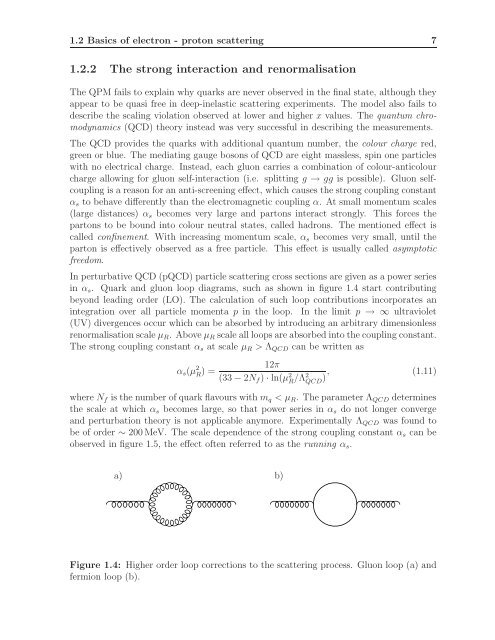10 - H1 - Desy
10 - H1 - Desy
10 - H1 - Desy
You also want an ePaper? Increase the reach of your titles
YUMPU automatically turns print PDFs into web optimized ePapers that Google loves.
1.2 Basics of electron - proton scattering 7<br />
1.2.2 The strong interaction and renormalisation<br />
The QPM fails to explain why quarks are never observed in the final state, although they<br />
appear to be quasi free in deep-inelastic scattering experiments. The model also fails to<br />
describe the scaling violation observed at lower and higher x values. The quantum chromodynamics<br />
(QCD) theory instead was very successful in describing the measurements.<br />
The QCD provides the quarks with additional quantum number, the colour charge red,<br />
green or blue. The mediating gauge bosons of QCD are eight massless, spin one particles<br />
with no electrical charge. Instead, each gluon carries a combination of colour-anticolour<br />
charge allowing for gluon self-interaction (i.e. splitting g → gg is possible). Gluon selfcoupling<br />
is a reason for an anti-screening effect, which causes the strong coupling constant<br />
α s to behave differently than the electromagnetic coupling α. At small momentum scales<br />
(large distances) α s becomes very large and partons interact strongly. This forces the<br />
partons to be bound into colour neutral states, called hadrons. The mentioned effect is<br />
called confinement. With increasing momentum scale, α s becomes very small, until the<br />
parton is effectively observed as a free particle. This effect is usually called asymptotic<br />
freedom.<br />
In perturbative QCD (pQCD) particle scattering cross sections are given as a power series<br />
in α s . Quark and gluon loop diagrams, such as shown in figure 1.4 start contributing<br />
beyond leading order (LO). The calculation of such loop contributions incorporates an<br />
integration over all particle momenta p in the loop. In the limit p → ∞ ultraviolet<br />
(UV) divergences occur which can be absorbed by introducing an arbitrary dimensionless<br />
renormalisation scale µ R . Above µ R scale all loops are absorbed into the coupling constant.<br />
The strong coupling constant α s at scale µ R > Λ QCD can be written as<br />
α s (µ 2 R ) =<br />
12π<br />
(1.11)<br />
(33 − 2N f ) · ln(µ 2 R /Λ2 QCD<br />
),<br />
where N f is the number of quark flavours with m q < µ R . The parameter Λ QCD determines<br />
the scale at which α s becomes large, so that power series in α s do not longer converge<br />
and perturbation theory is not applicable anymore. Experimentally Λ QCD was found to<br />
be of order ∼ 200 MeV. The scale dependence of the strong coupling constant α s can be<br />
observed in figure 1.5, the effect often referred to as the running α s .<br />
2 A4?A4 " G; 2G h !6K<br />
2 A4?A4 " G; 2G h !6K<br />
a) b)<br />
Figure 1.4: Higher order loop corrections to the scattering process. Gluon loop (a) and<br />
fermion loop (b).<br />
RV- 6 G2 -2 G !262G 04- O Y 6 6-!6K<br />
RV6K RV- 6 G2 -2 G !262G 04- 3FHG.IKJKIBL$MNL$Ï O Y 6 6-!6K<br />
RV6K<br />
¢¡¤£¦¥¨§©¤¦ !#"$%%!"'&%(*)+ -,.*%,/<strong>10</strong>¨2¢(&34*5(67*)0!8:9;$:567*)+5?@8BA¢C&!>;
















